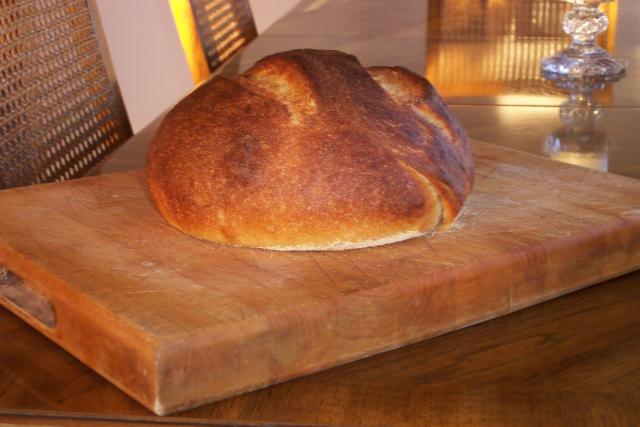I've had a number of discussions with TFL participants recently about sourdough rise times versus temperature and inoculation. Temperature has a big effect on sourdough rise times, and sometimes a starter appears unhealthy, when it is really just rising more slowly because of low temperatures in the kitchen during winter. Also, recipes that used to work seem to fail during the winter, but the colder temperatures may be the cause. To adjust for cold winter kitchen temperatures, either the temperature must be managed actively (oven with pilot light or electric light, coolers with a bowl of warm water in them, and so on), or the percentage of fermented flour must be adjusted in the recipe, or much more time must be allowed for the bulk fermentation and proofing.
I constructed a table that provides (in hours) the doubling time, bulk fermentation time, proofing time, and total mix-to-bake time for various temperatures and percentages of fermented flour. The table has two sections, one for no salt meant for unsalted levains, and one for 2% salt meant for doughs or salted levains.
Inoculation, as used in the table, is the percentage of fermented flour contributed by a levain or storage starter to the total flour in a levain or dough. For example, if 50g of storage starter at 100% hydration is contributed to 225g of flour and 175g of water to create a levain, then the total flour is 250g (25g+225g) and the percentage of fermented flour is 10% (25g out of 250g total flour). Similarly, if a dough containing 1Kg of total flour is made by contributing the levain just mentioned to 750g of flour and 550g of water and 20g of salt, then the inoculation or percentage of fermented flour is 25%, or 250g out of a total flour of 1Kg.
The table is made to match up to rise times for whole wheat, high extraction, or generally high ash content flours I tend to use in my sourdough hearth breads. For pure white flour doughs and levains, the times tend to be about 20% longer, i.e. white flour rises a little more slowly.
Your starter may well be faster or slower than mine. If you build a test levain using a representative entry in the table, such as 10% at 75F, you can see how your starter compares to these table entries and then adjust your rise times and proof times up or down by the same percentage. For example, if you starter doubles in 80% of the time indicated in the table, then it makes sense to use 80% of the time in the table for other temperatures and inoculations also.
You can see from the table that the rise times vary over a huge range depending on temperature. Also, inoculations need to be changed drastically for long overnight rises, depending on temperature.
The strategy for maintaining a starter should also change dramatically if the temperature is 65F instead of close to 80F in the kitchen from winter to summer. For example, a 25% inoculation at 65F results in a 10 hour mix-to-bake time, which is a couple of hours before a levain would peak and begin to collapse, but at 80F an inoculation of only 0.5% results in a 10 hour mix-to-bake time. I've used this model at wide ranges of temperature and had reasonable results. The interesting thing to notice is that a 20g:30g:30g feeding at 65F peaks in around 12 hours but a 1g:100g:100g feeding at 80F peaks in around 12 hours, too. Or, if you look at the mix-to-bake time at 65F for a 10g:45g:45g feeding (10% inoculation), it's 12.5 hours, so if you feed that way at 65F the starter won't be getting to its peak and may be overfed if the feeding is repeated every 12 hours, while the same feeding at 80F will peak in less than 8 hours, so a 12 hour schedule will work well at that temperature.
This is simplified from my rise time models, so it doesn't include some additional adjustments for the dough consistency I make in my spreadsheets. Of course, this is a very rough approximation. All kinds of complications may cause these numbers to be different from actual results. So, it's just a guideline and something to think about, and it's biggest use may be as a learning tool or to just get in the general ballpark for rise times. For example, if your temperatures are very different from the ones the author assumed in the recipe, or if you just don't have an idea where to start with rise times for some recipe your trying, maybe the table will help.
Apologies in advance, if it turns out there is a bug in the table somewhere, but at least some of the numbers made sense after browsing through the table.







